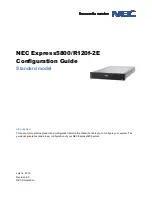
144
Copyright@2004~2014 Qsan Technology, Inc. All Rights Reserved.
Qsan Document – User Manual
Difference
MC/S is implemented on iSCSI level, while MPIO is implemented on the higher level. Hence, all
MPIO infrastructures are shared among all SCSI transports, including Fiber Channel, SAS, etc. MPIO
is the most common usage across all OS vendors. The primary difference between these two is
which level the redundancy is maintained. MPIO creates multiple iSCSI sessions with the target
storage. Load balance and failover occurs between the multiple sessions. MC/S creates multiple
connections within a single iSCSI session to manage load balance and failover. Notice that iSCSI
connections and sessions are different than TCP/IP connections and sessions. The above figures
describe the difference between MPIO and MC/S.
There are some considerations when user chooses MC/S or MPIO for multi-path.
1.
If user uses hardware iSCSI off-load HBA, then MPIO is the only one choice.
2.
If user needs to specify different load balance policies for different LUNs, then MPIO should
be used.
3.
If user installs anyone of Windows XP, Windows Vista or Windows 7, MC/S is the only option
since Microsoft MPIO is supported Windows Server editions only.
4.
MC/S can provide higher throughput than MPIO in Windows system, but it consumes more
CPU resources than MPIO.
Trunking and LACP
Link aggregation is the technique of taking several distinct Ethernet links to let them appear as a
single link. It has a larger bandwidth and provides the fault tolerance ability. Beside the advantage
of wide bandwidth, the I/O traffic remains operating until all physical links fail. If any link is
restored, it will be added to the link group automatically.
LACP
The Link Aggregation Control Protocol (LACP) is a part of IEEE specification 802.3ad. It allows
bundling several physical ports together to form a single logical channel. A network switch
negotiates an automatic bundle by sending LACP packets to the peer. Theoretically, LACP port can
be defined as active or passive. Qsan controller implements it as active mode which means that
LACP port sends LACP protocol packets automatically. Please notice that using the same
configurations between Qsan controller and gigabit switch.
The usage occasion of LACP:
It’s necessary to use LACP in a network environment of multiple switches. When adding new
devices, LACP will separate the traffic to each path dynamically.
















































